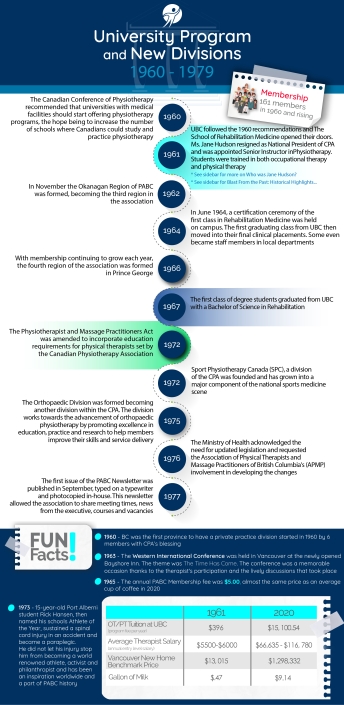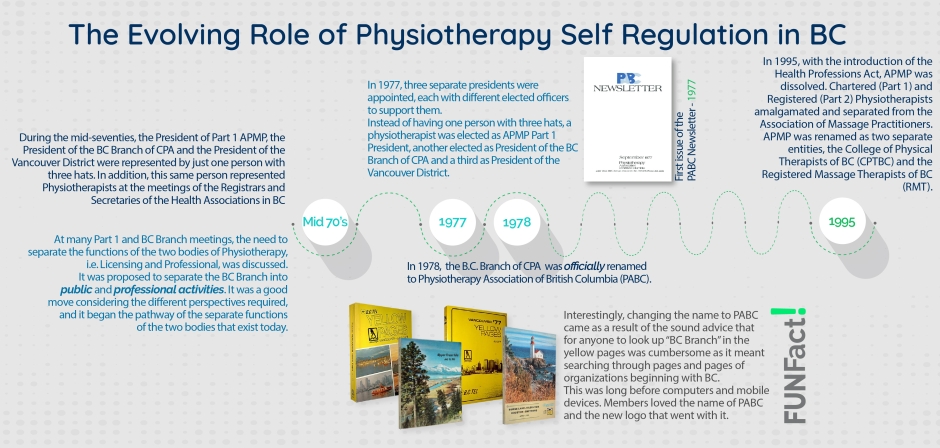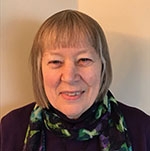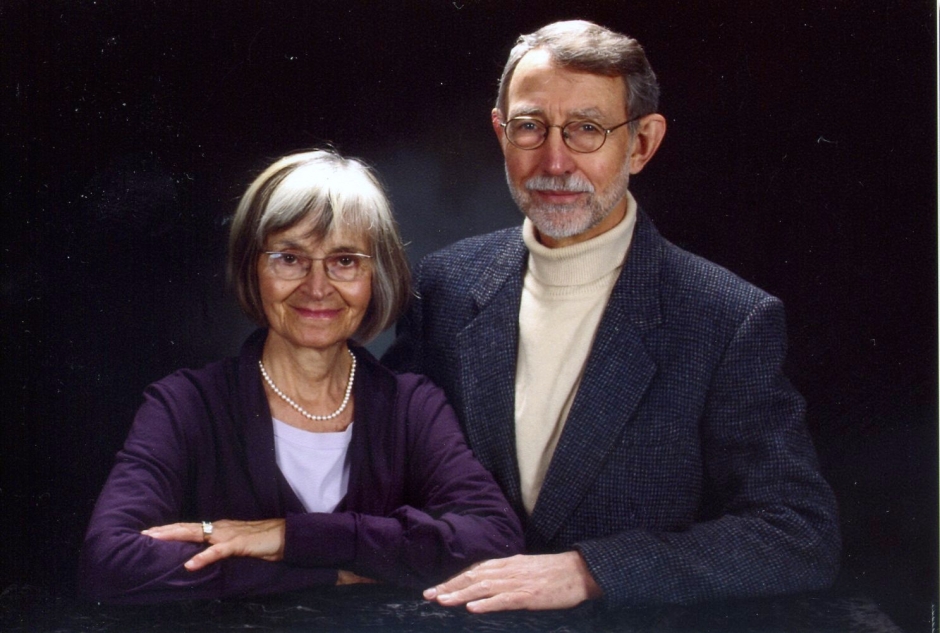The 1960s and 1970s were the beginning of a new era for the association.
Prior to 1960, McGill University, The University of Toronto, and The University of Alberta were the only universities in Canada to offer physiotherapy programs. In 1960 the Canadian Conference of Physiotherapy recommended that universities with medical facilities should start offering physiotherapy programs, the hope being to increase the number of schools were Canadians could study and practice physiotherapy. UBC followed this recommendation and The Department of Physical Therapy, formerly known as the School of Rehabilitation Medicine, opened its doors in 1961. It was then that Miss Jane Hudson resigned as National President of CPA and was appointed Instructor in Physiotherapy. Members were delighted with this news. At the time, students were dual trained in both occupational therapy and physical therapy.
In November 1962 the Okanagan Region of PABC was formed, becoming the third region in the association. The first graduating class from UBC moved into their final clinical placements in 1964 and many went on to become staff members in local departments. To those members who had volunteered on endless committees and prepared outlines of courses at UBC since 1948, this moment was extraordinary. With membership continuing to grow each year, the fourth region of the PABC formed in Prince George in 1966.
In 1972 the Physiotherapist and Massage Practitioners Act was amended to incorporate education requirements for physical therapists set by the Canadian Physiotherapy Association. Sport Physiotherapy Canada, a division of the CPA, was founded in 1972 and has grown into a major component of the national sports medicine scene. In 1975 the Orthopaedic Division was formed within the CPA. The Orthopaedic Division works towards the advancement of orthopaedic physiotherapy by promoting excellence in education, practice and research to help members improve their skills and service delivery. The Ministry of Health acknowledged the need for updated legislation and requested the Association of Physical Therapists and Massage Practitioners of British Columbia’s (APMP) involvement in developing the changes in 1976 as well. 1977 was also an exciting year for PABC as the first issue of the PABC Newsletter was published in September, typed on a typewriter and photocopied in-house. This newsletter allowed the association to share meeting times, news from the executive, courses and vacancies


Health Sciences Association and the History of Physical Therapy in BC
Rumours of unionization of Health Care Workers in Vancouver, BC, began in the early 1970’s. Thus, the Health Sciences Association (HSA) was born as an alternative to the other larger unions in B.C., beginning with 9 founding disciplines – Physiotherapists, Occupational Therapists, Dietitians, Pharmacists, Social Workers, Laboratory Technologists, Radiology Technologists, Medical Record Librarians and Remedial Gymnasts. From the 9 disciplines that made up the founding group, in 2020 HSA now represents about 150 different health disciplines.
Explore more about Physiotherapists and the Early History of Health Sciences Association (HSA) - Written by Bruce M. Clark, July 23, 2020.
Re-entry Course for Physiotherapists held through BCIT in 1977 and 1978
In the late nineteen seventies, in spite of the numbers of Physiotherapists graduating from UBC, (as it was a combined PT/OT course, some graduates became Occupational Therapists) there was a continuing and increasing need for physiotherapists with many vacancies around the Lower Mainland.
An Advisory Committee was formed with Roy Morris, representing BCIT, Wally McBride from Canada Manpower, Ray Hindle from Ministry of Education, Lou McGregor from UBC, Madeline Schouten from CPA, Ruby Reid and Pat Glover from APMP Part 1, and Ruth Fortune as Course Designer.
Working with the Advisory Committee, Mrs. Ruth Fortune planned and coordinated the courses for the Re-Entry for Physiotherapists in 1977 and 1978, offered through the British Columbia Institute of Technology (BCIT). On completion, ten physiotherapists in 1977 and ten in 1978 returned to the workforce. These courses were sponsored by Canada Manpower, therefore there were no registration fees. Criteria for admission was eligibility for membership in APMP Part 1, a considerable time since active practice, and a commitment to look for a job at the successful completion of the course.
The two courses were of 12 weeks duration with 6-hour days, 5 days a week. The time was divided into four sections of three weeks each in Orthopaedics, Chests, Neurology, and an “Other” section which was made up of specialties such as Burns, Amputees, Spinal Cord injuries, etc.
Each section was made up of one week of lecture-demonstration with practice in a classroom setting immediately followed by a clinical placement in one of the local teaching hospitals. The placement was in the area just studied and under the supervision of one of the clinical therapists. Teaching was done by a combination of UBC faculty and clinical therapists with special experience. A number of Library books were purchased for loan by the Re-Entry students on a rotating basis.
The Re-Entry programs were considered to be very effective. Mrs. Ruth Fortune was sincerely thanked by all for her exemplary organizational skills.
Orthopeadic Division Timeline
In the early 70's two special interest groups were formed; Orthopaedic and Pediatric. By 1979 there were 7 special interest groups. In the early 80's, the CPA Board approved the transition from special interest groups to Divisions.
Read more about the History of Physiotherapy and the beginning of these divisions in Physiotherapy Practice July/August 2020 issue.
Take a look at some of the images collected over time, submitted by PABC members and their peers.





